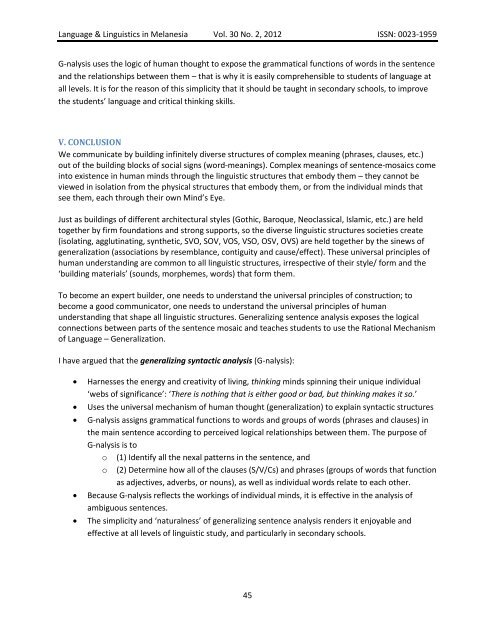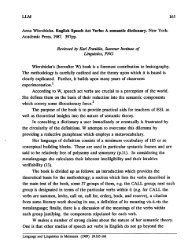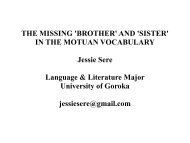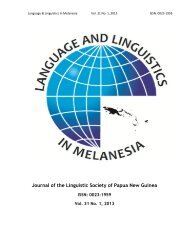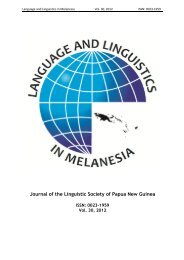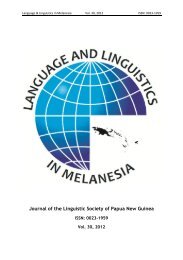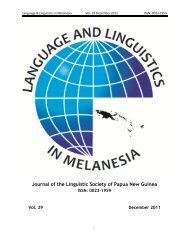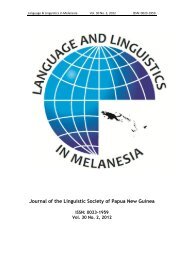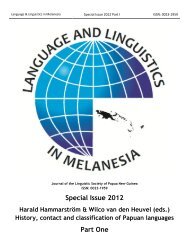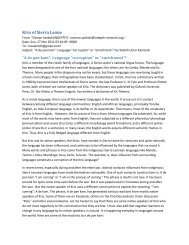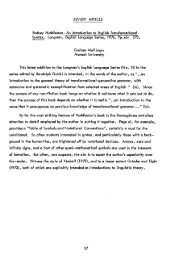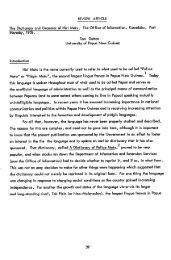Journal of the Linguistic Society of Papua New Guinea
Journal of the Linguistic Society of Papua New Guinea
Journal of the Linguistic Society of Papua New Guinea
Create successful ePaper yourself
Turn your PDF publications into a flip-book with our unique Google optimized e-Paper software.
Language & <strong>Linguistic</strong>s in Melanesia Vol. 30 No. 2, 2012 ISSN: 0023-1959<br />
G-nalysis uses <strong>the</strong> logic <strong>of</strong> human thought to expose <strong>the</strong> grammatical functions <strong>of</strong> words in <strong>the</strong> sentence<br />
and <strong>the</strong> relationships between <strong>the</strong>m – that is why it is easily comprehensible to students <strong>of</strong> language at<br />
all levels. It is for <strong>the</strong> reason <strong>of</strong> this simplicity that it should be taught in secondary schools, to improve<br />
<strong>the</strong> students’ language and critical thinking skills.<br />
V. CONCLUSION<br />
We communicate by building infinitely diverse structures <strong>of</strong> complex meaning (phrases, clauses, etc.)<br />
out <strong>of</strong> <strong>the</strong> building blocks <strong>of</strong> social signs (word-meanings). Complex meanings <strong>of</strong> sentence-mosaics come<br />
into existence in human minds through <strong>the</strong> linguistic structures that embody <strong>the</strong>m – <strong>the</strong>y cannot be<br />
viewed in isolation from <strong>the</strong> physical structures that embody <strong>the</strong>m, or from <strong>the</strong> individual minds that<br />
see <strong>the</strong>m, each through <strong>the</strong>ir own Mind’s Eye.<br />
Just as buildings <strong>of</strong> different architectural styles (Gothic, Baroque, Neoclassical, Islamic, etc.) are held<br />
toge<strong>the</strong>r by firm foundations and strong supports, so <strong>the</strong> diverse linguistic structures societies create<br />
(isolating, agglutinating, syn<strong>the</strong>tic, SVO, SOV, VOS, VSO, OSV, OVS) are held toge<strong>the</strong>r by <strong>the</strong> sinews <strong>of</strong><br />
generalization (associations by resemblance, contiguity and cause/effect). These universal principles <strong>of</strong><br />
human understanding are common to all linguistic structures, irrespective <strong>of</strong> <strong>the</strong>ir style/ form and <strong>the</strong><br />
‘building materials’ (sounds, morphemes, words) that form <strong>the</strong>m.<br />
To become an expert builder, one needs to understand <strong>the</strong> universal principles <strong>of</strong> construction; to<br />
become a good communicator, one needs to understand <strong>the</strong> universal principles <strong>of</strong> human<br />
understanding that shape all linguistic structures. Generalizing sentence analysis exposes <strong>the</strong> logical<br />
connections between parts <strong>of</strong> <strong>the</strong> sentence mosaic and teaches students to use <strong>the</strong> Rational Mechanism<br />
<strong>of</strong> Language – Generalization.<br />
I have argued that <strong>the</strong> generalizing syntactic analysis (G-nalysis):<br />
<br />
<br />
<br />
<br />
<br />
Harnesses <strong>the</strong> energy and creativity <strong>of</strong> living, thinking minds spinning <strong>the</strong>ir unique individual<br />
‘webs <strong>of</strong> significance’: ‘There is nothing that is ei<strong>the</strong>r good or bad, but thinking makes it so.’<br />
Uses <strong>the</strong> universal mechanism <strong>of</strong> human thought (generalization) to explain syntactic structures<br />
G-nalysis assigns grammatical functions to words and groups <strong>of</strong> words (phrases and clauses) in<br />
<strong>the</strong> main sentence according to perceived logical relationships between <strong>the</strong>m. The purpose <strong>of</strong><br />
G-nalysis is to<br />
o (1) Identify all <strong>the</strong> nexal patterns in <strong>the</strong> sentence, and<br />
o (2) Determine how all <strong>of</strong> <strong>the</strong> clauses (S/V/Cs) and phrases (groups <strong>of</strong> words that function<br />
as adjectives, adverbs, or nouns), as well as individual words relate to each o<strong>the</strong>r.<br />
Because G-nalysis reflects <strong>the</strong> workings <strong>of</strong> individual minds, it is effective in <strong>the</strong> analysis <strong>of</strong><br />
ambiguous sentences.<br />
The simplicity and ‘naturalness’ <strong>of</strong> generalizing sentence analysis renders it enjoyable and<br />
effective at all levels <strong>of</strong> linguistic study, and particularly in secondary schools.<br />
45


